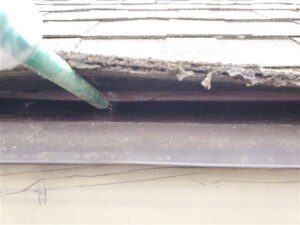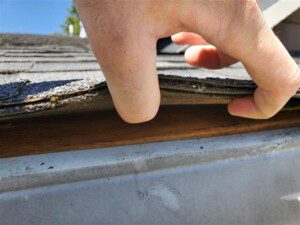
First, lack of roof edge flashing can allow water to seep under the roof shingles where it can damage the fascia boards, barge boards, roof sheathing, and underlayment. Over time excessive moisture in these areas can lead to delamination of the roof shingles and decay of the fascia and barge boards or roof sheathing. This can result in roof leaks and gutter failure.
Next, roof edge flashing also helps to protect the gap under the roof sheathing from insect intrusion into the attic space. Additionally, wood destroying organisms such as carpenter ants, wood boring beetles, termites, and fungi are attracted to wood with a high moisture content. Roof edge flashing helps to keep the wooden areas at the edges of the roof dry, which in turn helps to prevent wood destroying organism activity.
There are important considerations to keep in mind when inspecting the installation of roof edge flashing. It should be fastened directly to the roof sheathing and should be installed before the shingles are installed. The roof underlayment should overlap the roof edge flashing at the eaves and be overlapped by the roof edge flashing at the rakes. Improper overlap of the underlayment can allow moisture to seep behind the flashing where it can reach the roof sheathing.
Another common installation defect is improper gutter overlap. This occurs when the gutters are installed on top of the edge flashing. This condition can cause water to drip behind the gutters which can lead to excessively high water levels in the soil next to the home’s foundation. High moisture levels in the soil at the foundation can affect the soil’s ability to support the weight of the structure above. This can lead to foundation settling and increases the likelihood of structural damage. Water dripping behind the gutters can also lead to rafter end and/or fascia decay.

Inadequate Flashing
Many older homes do not have roof edge flashing installed. However, in 2012 the IRC (International Residential Code) made roof edge flashing a requirement for all new construction with asphalt shingles. There are specific requirements that the IRC has for roof edge flashing installation. First, there must be a minimum of 2 inches of overlap for adjoining sections of flashing. Additionally, flashing must overlap the roof sheathing by a minimum of ¼ inch, and extent up the sheathing a minimum of 2 inches.
Home inspectors or other qualified persons can determine the presence of roof edge flashing at the eaves by lifting up the edges of the shingles. Flashing at the rakes is typically visible from the ground level.
Takeaway: Roof edge flashing is an important component in helping to protect a home from a variety of potential concerns. Consult with your local Certified Professional Home Inspector to determine if your home has roof edge flashing. Roof edge flashing can save a homeowner from potentially costly issues down the road.
